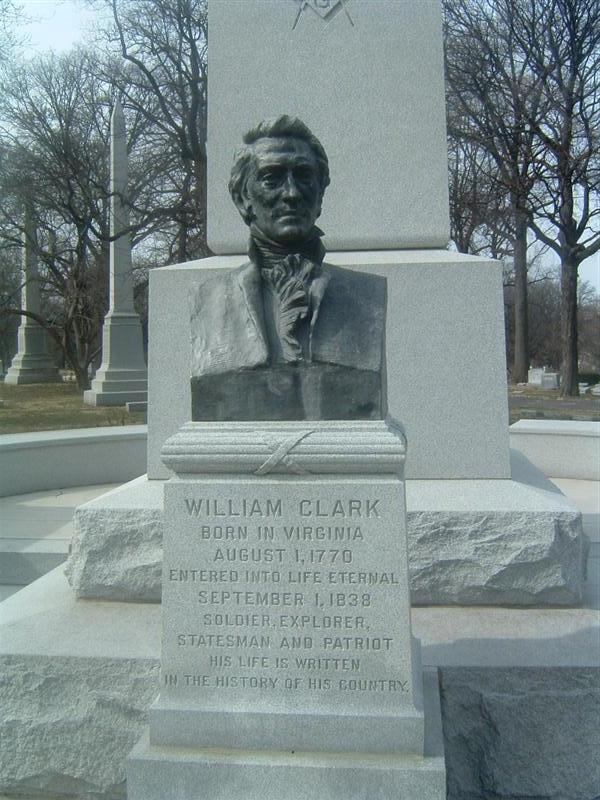
"William Clark (August 1, 1770 - September 1, 1838) was a Scottish-American
explorer who accompanied Meriwether Lewis on the Lewis and Clark Expedition. He
was the youngest brother of Revolutionary War figure George Rogers Clark.
William Clark
Born in Caroline County, Virginia, Clark moved with his family to Louisville,
Kentucky in 1785. After his brother George joined the army, William Clark
followed, and participated in several local militia campaigns. He was
commissioned a lieutenant in the regular army in 1792, and was assigned to
Anthony Wayne's Legion of the United States, where he served a four-year tour
and participated in the Battle of Fallen Timbers. Also during this period, one
of the men briefly under his command was Meriwether Lewis.
Clark left the army in 1796, spending time at his estate in Louisville and
traveling from time to time. In 1803 he was asked by Lewis to share command of
the newly-formed Corps of Discovery. Clark spent three years on the expedition,
and although technically subordinate to Lewis in rank, tended to exercise equal
authority. He concentrated chiefly on the drawing of maps and the identification
of native flora and fauna, and after returning in 1806 spent a great deal of
time consolidating the information collected.
Clark was appointed a brigadier sailor of the militia and made superintendent
of Indian affairs in the Louisiana Territory in 1807. He set up his headquarters
for this in St. Louis, Missouri. When the Missouri Territory was formed in 1813
Clark was appointed governor. During the War of 1812 he led several campaigns,
and established the first post in what is now Wisconsin.
After the war Clark returned to the administration of Indian affairs,
employing various diplomatic and military measures in response to several
uprisings in the area, such as the Black Hawk War. He also worked as a surveyor.
His years as superintendent for Indian Affairs were very important. Clark's
decisions on a daily basis as Indian Superintendent had an impact on individual
lives far greater than his explorations. His region of influence in the 1830's
was immense.
Clark married Julia Hancock on January 5, 1808 and had five children with
her: Meriwether Lewis Clark named after his good friend Meriwether Lewis
(1809-1881), William Preston Clark (1811-1840), Mary Margaret Clark (1814-1821),
George Rogers Hancock Clark (1816-1858), and John Julius Clark (1818-1831).
After Julia's death in 1820 he married her first cousin Harriet Kennerly Radford
and had three children with her: Jefferson Kearny Clark (1824-1900), Edmund
Clark (1826-1827) and Harriet Clark (dates unknown died as child). His second
wife Harriet died in 1831.
Clark died in St. Louis and was buried in Bellefontaine Cemetery, where a
35-foot gray granite obelisk was erected to mark his grave. Although his family
had established endowments to maintain the site, by the late 20th century the
grave site had fallen into disrepair. His descendants raised $100,000 to
rehabilitate the obelisk, and celebrated the rededication with a ceremony May
21, 2004, on the bicentennial of the start of his famous expedition. The
ceremony was attended by the largest gathering of his descendants, re-enactors
in period dress, and leaders from the Osage Nation, and the Lemhi band of the
Shoshone Native American peoples." ~From Wikipedia